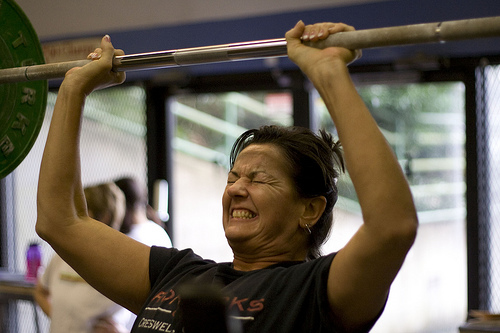It is often said that, rather than training to failure, you should leave one repetition left “in the tank.” I think this is good advice, particularly when you’re performing a max or near-max set (obviously, this advice doesn’t apply for sub-maximal sets). But what exactly does that mean? If you ask a few different trainers, you’ll probably get a few different answers. And there can be very stark consequences for very subtle differences. So, here’s what I usually recommend and why.

But first, a little insight into what I mean when I say “max or near-max training.” I’m not talking about sub-maximal “I sortof think I probably worked hard for a second there” type of training. I’m referring to true maximal effort work, where you are at or near your actual physical limitations. Only intermediate to advanced athletes can really tap into this level of training, and its difficult to do without a coach or, at the very least, a training partner. If you’re still not sure what this looks like, then the article here may help, or you can watch an example of a maximal set in a video I shot here. Now that that’s out of the way…
I rarely recommend training to muscle failure. That is, I rarely recommend performing such an all-out effort to the point of muscular disability – where you simply cannot do anything following a particular exercise set. I trained using this strategy for several years, and I’ve since abandoned it except on rare occasions – usually for testing purposes. Maybe it’s just that I don’t like showing weakness to anyone – even myself – but I just don’t understand the tendency to voluntarily incapacitate oneself. It makes me feel awfully vulnerable. But there are other reasons why it’s a good idea to avoid training to muscle failure, and the four most relevant ones, in my opinion are:
1) Training to failure requires more total recovery time and effort. The further you push in your intensity training, the greater the recovery demands will be. Training to failure is extremely taxing to not just the local musculature, but also the nervous system. This will require extra recovery time, and adjustments in your training schedule to accommodate. In the long run, your results will be hampered and you’ll actually need to train less, too.
2) If that wasn’t bad enough, not only will it take longer to recover, but the additional training adaptations you receive from the extra repetition or two you pushed for will be far less. Your return on investment decreases the closer to muscle failure that you get (ie AFTER you’ve reached the threshold for adaptation). So, at a certain point, the ROI just won’t be worth it and the risk of injury increases substantially.
3) If you repeatedly train to failure in your fitness program, your body will become conditioned to repeat that “failure” in the future (according to the SAID principle). So, training to muscle failure may result in experiencing muscle failure more often. This could be bad for those situations when, you know, you NEED your muscles to be working properly.
4) The closer you get to muscle failure, the harder it will be to maintain your technique. It will also be harder to realize whether or not you’re even using proper technique. In fact, the body has built-in survival mechanisms that will initiate subtle changes in your movement patterns to take the load off of an already stressed pattern. This is why someone who is doing strict pullups will start to kip slightly towards the end of their set. The body is trying to keep working without continuing to fatigue the primary muscles involved in the exercise – even if it results in using an improper technique that is more likely to cause pain and injury. So, as each set progresses, it will get harder and harder to maintain good technique and your body will actually want to use poor technique to compensate for the increasing fatigue.
So, when I say to leave one repetition in the tank, what I mean is to NOT train to muscle failure. In other words, don’t go to the point where you can do no more.
When do you cease repping out?
So, how do you leave a rep in the tank? Well, when you’re getting towards the end of a set (say you were trying for something in the 8-12 rep range), and you get to the point where either a) you can no longer maintain excellent technique (ie 8+ out of 10 on a technique rating scale), or b) you’re almost certain that the next repetition will result in muscle failure, THAT’S when you stop. Don’t try to squeeze in one last sloppy repetition, and NEVER train to the point where you cannot maintain the basic technique. Instead, devote your utmost attention to your technique and ramp up the intensity as much as your form will hold.
You should be able to function normally during and after your strength training sessions – even your high intensity sessions (especially those!). Make this a rule for yourself, and allow yourself the luxury of breaking the rules once in awhile when you’d like to see what you can really do in a training session.
If you found this article helpful, please share it with your friends and tweeps:
.jpg)
![]()
CST Coach, CST-KS
Health-First Fitness Coach
P.S. If you liked this post, then please signup for the newsletter, or follow me on Facebook or Twitter for daily updates and other interesting info.
P.P.S. Photo credit: http://www.flickr.com/photos/jontunnell